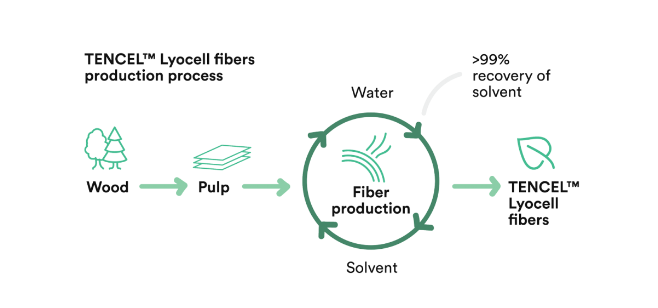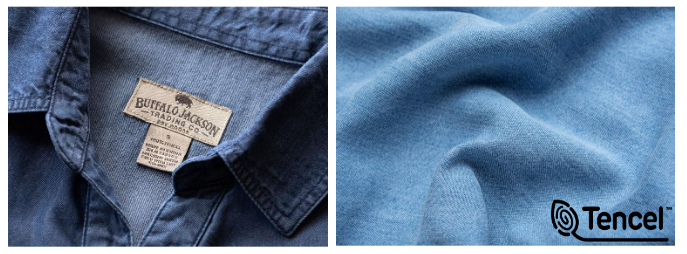In a world where the environment is at risk, people are realizing that the things they buy can do more than look good and feel comfortable. Sustainable fashion is becoming more popular because it helps us reduce our impact on the environment and promotes more ethical ways of making clothes. Amidst this movement, Tencel has emerged with a goal to bring significant change in the fashion and textile industries through innovative collaboration.
History and Development:
TENCEL is a brand name which is owned by the Austrian company named Lenzing AG. TENCEL comes in two forms of fibers: TENCEL™ Lyocell and TENCEL™ Modal. These fibers are renowned for their remarkably soft texture and are widely used sustainably.
Lyocell, later branded as Tencel, was developed in the 1970s as a sustainable and environmentally friendly alternative to rayon and other cellulosic fibers. In the 1980s, Courtaulds, a British multinational textile and chemicals company, acquired the licensing for lyocell technology, making a significant development breakthrough. Tencel was officially launched in 1992, using a closed-loop production process, setting it apart from traditional rayon and other cellulose fibers. It gained popularity in the 2010s due to increasing consumer interest in sustainability and ethical sourcing. Today, Lenzing AG is the largest producer of Tencel, making about 130,000 tonnes per year.
Production process:
Tencel and rayon (i.e. viscose) are both types of fabric made from “regenerated cellulose” fibers. The production of Tencel is based on the technology of the lyocell process, where wood pulp from trees like eucalyptus, beech, and spruce is dissolved in a non-toxic to create a fiber solution. This solution is then extruded to form fibers. These fibers can be used to make clothes either on their own or mixed with other fabrics.
Tencel is known for being sustainable and has been called “feel good fibers” since 1992, making it a hit among fans of slow fashion.

Tencel vs. Other Fabrics:
Tencel and cotton are both natural fibers, but they differ in several key aspects. It is manufactured using a closed-loop system that recycles 99% of the solvent used. In contrast, conventional cotton production is highly resource-intensive and requires about 2,700 liters of water to produce a single cotton shirt. Moreover, cotton farming involves the use of pesticides and fertilizers, which can have harmful effects on the environment. In terms of performance, It is softer and more breathable than cotton, and it has excellent moisture-wicking properties, making it ideal for activewear and sensitive skin. However, cotton is more readily available and often more affordable than it.
The production of Rayon, including viscose, usually requires a more chemically intensive process with hazardous substances such as carbon disulfide and sodium hydroxide, which can cause great harm to both workers and the environment. Producing 1 kilogram of rayon consumes around 2,500 liters of water, whereas Tencel’s production process is significantly less water-intensive. Moreover, Tencel fibers are stronger and long-lasting than rayon, even when they get wet. But it is generally more expensive than Rayon.
Linen is renowned for its breathability and durability, but it tends to be stiffer and prone to wrinkle easily. On the other hand, tensile gives a smooth and silky feel, which is great for dresses and activewear and provides a good fit. Moreover, linen production uses about 650 liters of water per kilogram of fiber. It decomposes faster and more completely than linen because it has higher purity and lower lignin content. Tencel lyocell has been proven to biodegrade fully within 30 days in marine conditions. Which is why they are famously known for “comes from nature and returns to nature.”
Top Fashion Brands Using TENCEL:
A number of fashion brands are at the forefront of utilizing it. Allbirds, based in the United States, is famous for its sustainable footwear and apparel, featuring Tencel, with prices starting at around $95. Meanwhile, Amour Vert, an American brand established in 2012, focuses on high-quality, sustainable women’s clothing and incorporates Tencel in items like dresses and blouses, with prices ranging from $50 to $200. Additionally, Tentree is committed to environmental sustainability, planting ten trees for every item sold, and offers a range of Tencel clothing options priced from $14 to $328. Toad&Co specializes in travel-friendly clothing made from it. At the same time, Organic Basics emphasizes sustainable basics crafted from it and other eco-friendly materials, priced between $16 and $48, with a focus on lasting and versatile designs.




